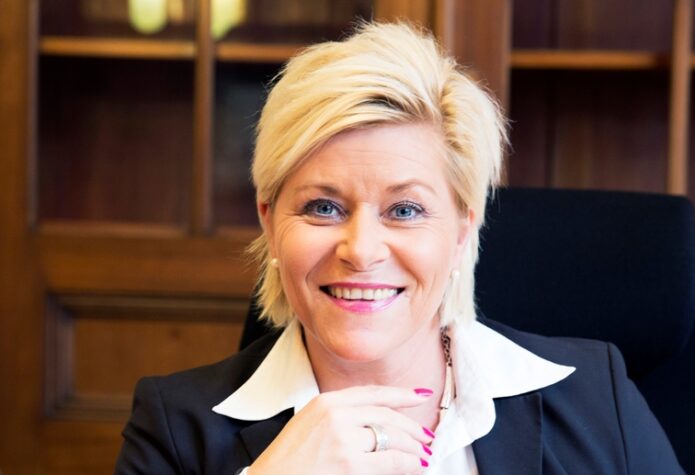Finance Minister of Norway: “Finance the future, not the past”

Siv Jensen, Minister of Finance of Norway. Photo: Rune Kongsro / Ministry of Finance
“The year 2016 showed that the Nordic Investment Bank is an efficient funding tool for the Nordic–Baltic region. The Bank’s ability to combine impact financing with sound banking principles shows up as a healthy profit on top of the societal gain”, says Siv Jensen, Minister of Finance of Norway, who chaired the annual meeting of NIB’s Board of Governors in 2017.
NIB Newsletter asked Ms Jensen to comment on the Bank’s annual results.
How would you comment on the Bank’s results in 2016?
With strong owners and a good track record, global investors trust the Bank and are willing to invest in NIB’s bonds. The Bank allocates these funds in the form of long-term lending to projects that stimulates sustainable economic growth and development.
In 2016, this regional “funding machine” worked very efficiently. The Bank’s ability to combine impact financing with sound banking principles shows up as a healthy profit, EUR 212 million in 2016, on top of the societal gain.
How do you position NIB compared with other international organisations?
NIB aims to move our region forward through long-term financing. You could say that many other financiers also do that, but in one aspect NIB is unique: it has its roots in Nordic operation, but today it is clearly the most tangible institution for Nordic–Baltic cooperation.
With only eight members, each of the owners has a significant impact, which is less the case in bigger international organisations. Even the biggest members are relatively small on a world scale, and we share rather similar values. By combining forces, we can achieve more.
Should the regional co-operation be fostered even more? If so, can you give some examples?
This year, Norway holds the presidency of the Nordic Council of Ministers, which coincides with us also having the chair of NB8 co-operation. We have put emphasis on finding more synergies and co-operation between the Nordic and Baltic countries.
Our region is already closely integrated. One good example is the electricity market. Norway has huge capacity for hydropower. When the wind is not blowing in Denmark, we can make up the shortfall. When it is windy there we can import power from our neighbor. We should look further to find such synergies and to continue to further integrate and develop the regional power market.
We can also look at new areas for co-operation. One example was the Nordic–Baltic ministerial conference on digitalisation which took place in Oslo in April. We are all performing well in terms of digitalisation, but better regional co-operation on digitalisation can improve competition in each country, and in the region as a whole.
What are the assets of the Norwegian economy?
One could say that as a country, we have been lucky to have abundant natural resources, but we have also made some wise decisions. We have managed the oil revenue well. We have high employment and a strong fiscal position. Our education system contributes to a well-educated work force. Income and welfare are more evenly distributed than in most countries.
Where do you see the challenges?
We also face challenges. One factor is that the oil and gas sector will no longer contribute to economic growth to the same extent as in the past.
I restrict myself to the challenges that have a link to NIB’s priorities and are most probably shared with NIB’s member countries.
One concern is low productivity. To ensure a continued increase in living standards, we need to find ways to reverse the trend of low productivity growth. Although the level of productivity in Norway is high, as in many other countries productivity growth has been relatively weak for the past decade.
Protecting the environment will also present significant challenges in the coming decades, and transitioning to a greener and more climate-friendly economy requires new ways of thinking, and will imply a new operating environment for the Norwegian private sector.
NIB celebrated its 40th anniversary last year. What is your message to the Bank?
In one sentence, the Bank should continue to finance the future. NIB’s mission to finance projects that improve competitiveness and the environment is highly relevant to the productivity challenge. Increasing productivity is necessary in order to maintain the essence of what has been branded as a Nordic model of society. Respect for the environment is a part of this model. It can also provide lucrative business opportunities for our region.